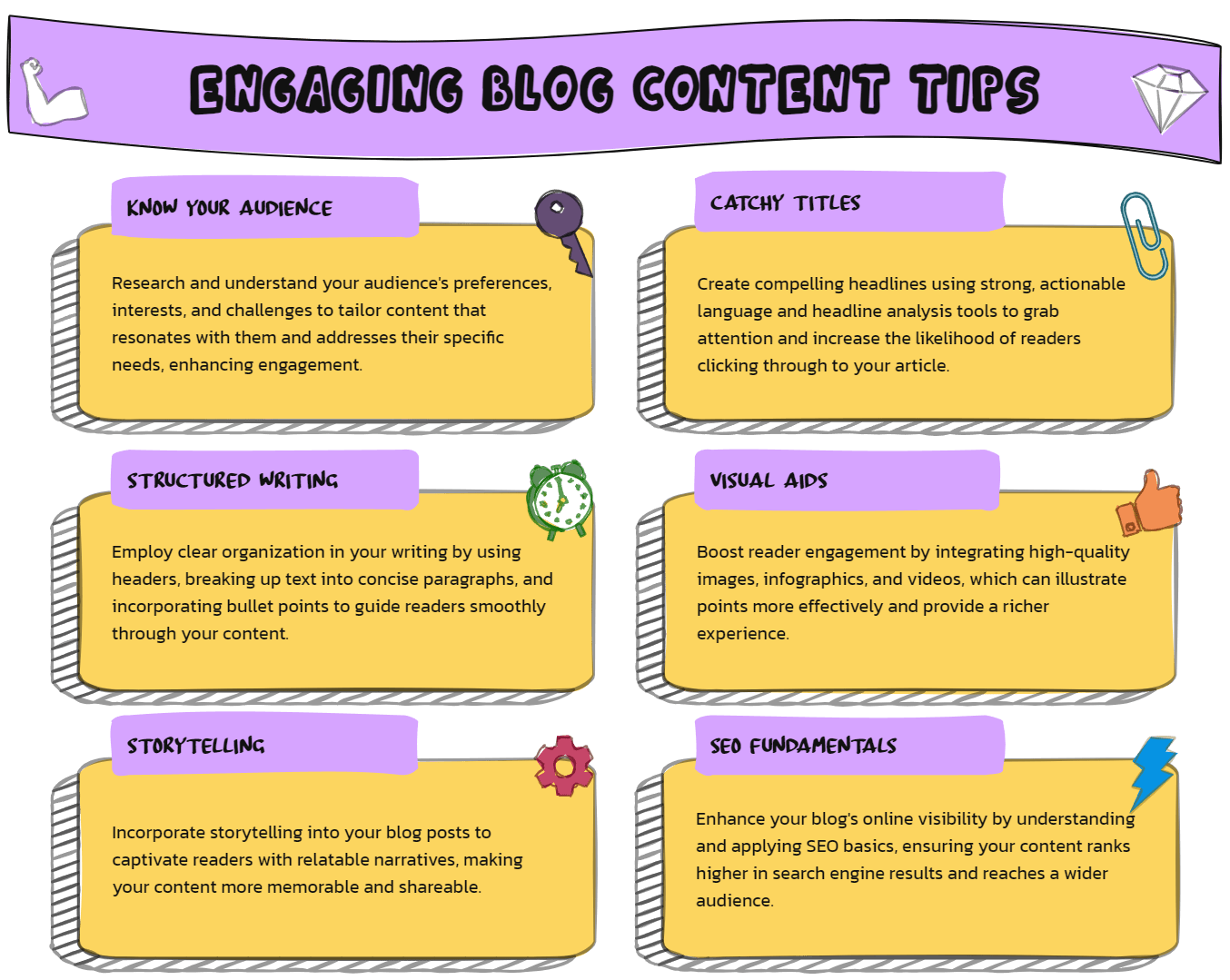

To write a blog[1] post that gets people’s attention, you need to know what your readers are interested in. Think of an eye-catching title, organize your ideas in a clear, logical way, and include pictures or videos to make it more attractive.
Telling a story can help your readers connect with your message on a deeper level. Don’t forget about SEO – using the right keywords and updating your content regularly can help more people find your blog.
Lastly, include a strong call to action to encourage your readers to interact with your post. All these strategies together can really boost your blog’s popularity. If you want to learn more, keep reading – there’s a lot more useful information to discover.
But what’s the secret to keeping your readers coming back for more? Stay tuned to find out.
And remember, the secret to a successful blog post isn’t just about what you say, but how you say it. Stay tuned for more tips on how to make your writing more engaging.
Knowing who reads your blog is key. It’s all about creating a clear picture of your ideal reader and making your content fit their wants and needs. You need to dig deep into facts like age, hobbies, and what keeps them up at night.
Tools like market studies and behavior patterns can help you learn more about what your readers want. By finding out what your readers are struggling with and what they love, you can create content that really speaks to them.
This deep knowledge of your readers not only helps you create customized content, but also helps you create a space where their worries are heard, making your blog more appealing to them.

In the blog writing realm, crafting catchy headlines is key to snagging readers’ attention. It influences the number of clicks your posts get. Making captivating headlines isn’t just an art, it’s a clever tactic to boost blog traffic.
When you come up with headlines, think about using action-packed words that spark a rush or thrill. Words like ‘Easy’, ‘Fast’, or ‘Proven’ can be handy, especially for readers who are hunting for answers. To make sure your headlines hit the mark, don’t shy away from using headline analyzer tools. These tools provide valuable feedback on how well your headlines might perform, helping you fine-tune them for maximum engagement.
If the thought of keyword research and content optimization feels overwhelming, we’re here to help. Our specialists are ready to tailor an SEO strategy that fits your unique needs and goals. Get in touch with us now via our contact page or chat with us instantly on WhatsApp for quick, professional assistance.
If you want your blog posts to grip your readers, you must think about how you arrange your words and ideas. This isn’t rocket science, it’s just about making your content easy to read and follow. Think of it as a road trip. You need clear signposts (headers), rest stops (paragraphs), and points of interest (bullet points). This makes the journey smooth and enjoyable for your readers.
A well-organized blog post isn’t just good-looking, it keeps readers hooked and helps them grasp your ideas better. It’s like giving them a map to navigate through your content easily, absorbing the key points as they go along. Plus, splitting up your text keeps the content flowing like a good conversation, making your blog even more captivating.
We’ve talked about the power of a well-structured blog. Now, let’s explore another important piece of the puzzle – making your blog visually attractive.
A quality image can boost reader interaction by a whopping 94%. It’s not just about making the blog look good, but also about enhancing the reader’s experience. Images that resonate with your brand can also bring more visitors to your website.
Simple visuals like charts, infographics, or even videos can help explain complicated ideas, making your blog reader-friendly.
Using stories in your blogs can make them more engaging and memorable. Think of it like this – when you tell a story, you’re not just sharing information. You’re painting a picture that your readers can connect with on an emotional level. This could be a personal story or an example from real life. Either way, it makes your content more relatable.
This doesn’t mean you should make up stories. Instead, use real examples and case studies to illustrate your points. This not only makes your content more interesting, but it also shows your readers how your ideas apply in the real world.
Did you know that blogs that use storytelling are 22 times more likely to be remembered? That’s a pretty powerful statistic. So, if you want to make your blogs more effective, consider adding some storytelling elements.
If you’re looking to make your blog more visible and reach a wider audience, getting a grip on Search Engine Optimization (SEO) basics is key. Start with keyword research. Figure out what your readers are searching for and the exact words they use. This insight allows you to craft content that matches their search needs, which will make your blog more attractive to both your audience and search engines.
Next, you have optimization. This involves smart use of your keywords in your titles, meta descriptions, and all throughout your content. But remember to keep things natural and avoid stuffing too many keywords.
And then, you’ve got to keep your blog fresh. Update it regularly. Search engines love new, timely content.
Lastly, don’t forget about internal links. Including these in your blog can enhance navigation, giving your SEO a serious lift.
In the world of blogging, crafting effective Calls to Action (CTAs) is a powerful way to boost reader interaction and guide them towards specific tasks. Did you know that a well-placed CTA can skyrocket click-through rates by an impressive 371%?
The secret is in using clear, direct language to inspire your readers to take action. The smart placement of these CTAs in your blog can dramatically up the interaction level. Sweeten the deal with incentives in your CTAs, and you’ll see a surge in participation and conversions.
And remember, try out different CTAs to discover the ones that work best in steering the actions you want. Master the skill of designing irresistible CTAs, and watch your blog’s performance soar.
To write a blog that hooks your readers, you need to follow three simple steps. First, make your content personal. This means using real-life examples or stories that your readers can relate to. Second, get to know your readers. Use data and feedback to understand what they like and don’t like. This will help you tailor your content to their preferences. Finally, use pictures, videos, or infographics to tell your story. This can make complex ideas easier to understand and keep your readers engaged. But remember, there’s more to creating engaging blog content. Stay tuned for more tips and tricks in our next post!
When you’re eager to craft a fresh blog post, the first step is digging deep into your topic. It’s like being a detective, uncovering the facts and figures that will make your content interesting and relevant. Think of your readers – who are they? What sparks their curiosity? Your post should be a feast for their minds, perfectly catered to their tastes.
Keep your writing simple and straightforward. Imagine you’re sitting down for a chat with a good friend. Your words should flow naturally, with a clear beginning, middle, and end. Remember Hemingway’s advice – short sentences and simple words are your best friends.
And just when you think you’ve given your readers all they could want, leave them craving more. A cliffhanger at the end of your post is like a promise of more exciting content to come. It’s a “to be continued…” that keeps them hooked and looking forward to your next post.
To write a successful blog article, you need to follow these five key steps. First, pick a topic that’s been well-researched and is relevant to your audience. Second, you need to make sure your article is packed with the right keywords to boost your SEO. Third, know who your readers are – their interests, needs, and behaviors. Fourth, structure your content in an engaging way that grabs the reader’s attention. Finally, write in a style that not only captivates your audience but also prompts them to interact and share your article. So, what do you think the sixth step might be? Stay tuned for more.
To create a fascinating blog, start with a topic that strikes a chord with your readers. Tell stories, ask questions, and get your audience involved. Use pictures, graphs, or videos to make your text easier to read and more enjoyable. Always remember, to write in a simple, straightforward manner. Hemingway’s rules suggest using shorter sentences and avoiding complex words. And don’t forget, you always want to leave your readers wanting more. So, what’s the secret to keeping them hooked for your next post? Well, that’s a story for another time.
